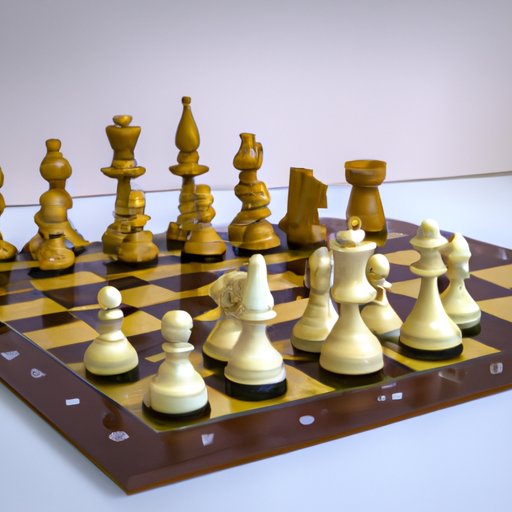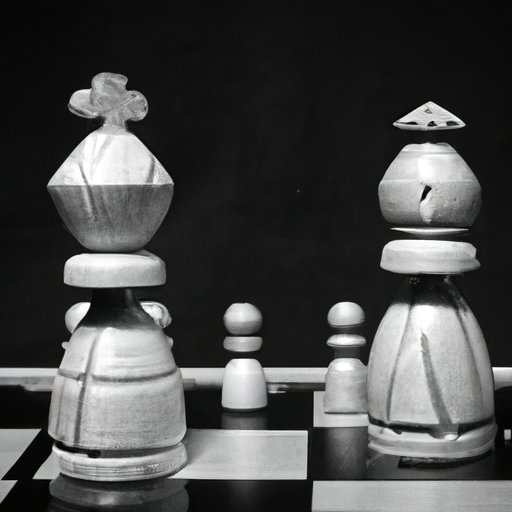
I. Introduction
As any chess player knows, the game can be complex and nuanced, with a variety of rules and strategies to master. One of the most important tactics in chess is castling, which can help players improve their defenses and gain an advantage over their opponents. However, there are some limitations to this move, and one of the most common questions that comes up is whether a player can castle while they are in check. In this article, we’ll explore this question and offer a comprehensive guide to castling in chess.
II. Rule of Castling: A Comprehensive Guide
First, let’s discuss what exactly castling is. Castling is a move that allows a player to move both their king and one of their rooks simultaneously, in order to improve the king’s safety and provide a pathway for other pieces to move around the board. Specifically, a player can castle when their king is in its starting position, the rook they want to move is also in its starting position, and all squares between the king and rook are unoccupied.
To perform castling, a player must move their king two spaces towards the rook they want to castle with, and then move that rook to the space immediately on the opposite side of the king. The king must be moved first, and the rook must be moved second. Additionally, the king cannot be in check when castling, and it cannot pass through or end on a square that is under attack by an opponent’s piece.
There are two types of castling in chess: kingside castling and queenside castling. Kingside castling involves moving the king two spaces towards the rook on the player’s right-hand side, and then moving that rook to the square immediately on the left-hand side of the king. Queenside castling involves moving the king two spaces towards the rook on the player’s left-hand side, and then moving that rook to the square immediately on the right-hand side of the king.
III. Avoiding the Common Mistake of Castling While in Check
One of the most common mistakes that chess players make is attempting to castle while their king is in check. This is not allowed, as castling can only be performed when the king is not in check.
There are several reasons why it’s important not to castle in check. First, it puts the king in an even more vulnerable position, as it essentially wastes a move and leaves the king in the same spot where it was just attacked. Additionally, castling while in check is not a legal move, and can result in the player losing the game.
There are several examples of what can happen if you attempt to castle while in check. For instance, if you try to castle kingside while in check, your opponent can simply capture the rook that you were trying to move. Similarly, if you try to castle queenside while in check, your opponent can attack the square immediately to the left of your king, making it impossible to castle at all.
IV. The Importance of Knowing When You Can Castle: Chess Tactics for Beginners
Now that we’ve covered the basics of castling and the importance of avoiding common mistakes, let’s talk about why it’s important to know when to castle. Castling is a crucial move in chess, as it can help improve the king’s safety and give players more options for moving their other pieces around the board.
One of the key aspects of successful gameplay is understanding chess tactics, or the different strategies and maneuvers that players can use to gain an advantage over their opponents. Knowing when to castle is a crucial part of these tactics, as it can help players improve their defenses or launch a counter-attack.
For beginners, it’s important to focus on recognizing when it is safe to castle. This means looking for opportunities when the king is not in danger, and when the rook and squares between the king and rook are unoccupied. It’s also a good idea to think about the long-term implications of castling, and how it will impact the game in the next few moves or later on in the match.
V. Mastering the Art of Castling in Chess: Tips and Tricks
Castling can be a complex move to master, especially for beginners who are still learning the ins and outs of the game. However, there are several tips and tricks that can help players improve their castling skills and make the most of this important chess tactic.
Some of the best tips for successful castling include looking for opportunities to castle early in the game, when the board is still relatively open and there are fewer pieces in play. Additionally, it’s important to keep an eye on the opponent’s pieces and potential attacks, and to avoid situations where the king might be vulnerable after castling.
Finally, it’s worth considering different scenarios where castling can be advantageous. For instance, if the opponent’s rook is positioned on an open file that leads directly to the king, castling on the opposite side of the board can help protect the king and improve the player’s position.
VI. How Castling in Check Affects the Outcome of the Game
We’ve already discussed why it’s important not to castle while in check, but what happens if a player does attempt to castle while their king is in danger? The answer is that the outcome of the game can be drastically impacted by this move.
If a player attempts to castle while in check, there are several potential consequences. In some cases, the player may lose an important piece like their rook, as opponents can take advantage of the illegal move to attack vulnerable pieces. Additionally, castling while in check can put the king in an even more vulnerable position, as it wastes a valuable move and fails to improve the king’s safety.
Overall, it’s crucial to consider the potential impact of castling in check before attempting this move. In most cases, it’s better to focus on other tactics and strategies to improve your position and avoid making costly mistakes.

VII. The Evolution of Castling in Chess: From Origins to Modern Day Play
Castling has a long and interesting history in chess, dating back to the earliest forms of the game in medieval Europe. Originally, castling was a much simpler move, and involved moving the king two spaces to one side or the other, without moving the rook.
Over time, castling evolved and became more complex, with the introduction of the modern rules that we still use today. These rules dictate that castling must involve moving both the king and the rook, and that it can only be performed under certain circumstances.
Today, castling is a crucial part of modern chess play, and is used by players at all levels of expertise to improve their positions and gain an advantage over their opponents. As the game continues to evolve and change, it’s likely that we will see castling continue to play a central role in chess tactics and strategy.
VIII. Castling Vs. Checkmate: Understanding the Difference and Its Impact on the Game
We’ve already discussed how castling is different from checkmate, but it’s worth exploring this topic in more detail, as understanding these two moves is crucial to improving your gameplay.
Checkmate is a move that ends the game, as it puts the king in a position where it would be captured on the next move, no matter what other moves are made on the board. Castling, on the other hand, is a defensive move intended to improve the king’s safety and provide more options for moving other pieces around the board.
Despite these differences, both castling and checkmate can have a significant impact on the outcome of the game. Knowing when to use these moves, and how to avoid mistakes and maintain a strong position, is crucial for players looking to improve their chess skills and gain an advantage over their opponents.
IX. Conclusion
In conclusion, castling is a crucial move in chess that can help players improve their position and gain an advantage over their opponents. However, it’s important to understand the rules and limitations of castling, and to avoid common mistakes like attempting to castle while in check.
By mastering the art of castling, recognizing the differences between castling and checkmate, and understanding the evolution of castling in chess history, players can take their gameplay to the next level and become more successful on the board.
We hope this guide has been helpful in answering the question of whether you can castle in check, and encourage players of all skill levels to continue improving their chess strategies and tactics.




